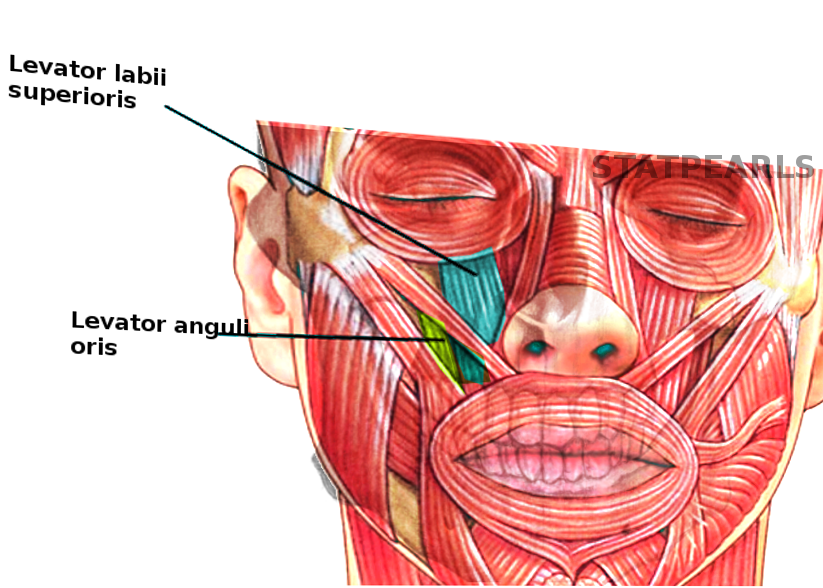[1]
Ferreira LM, Minami E, Pereira MD, Chohfi LM, Andrews Jde M. [Anatomical study of the levator labii superioris muscle]. Revista da Associacao Medica Brasileira (1992). 1997 Jul-Sep:43(3):185-8
[PubMed PMID: 9497543]
[2]
Hur MS, Youn KH, Hu KS, Song WC, Koh KS, Fontaine C, Kim HJ. New anatomic considerations on the levator labii superioris related with the nasal ala. The Journal of craniofacial surgery. 2010 Jan:21(1):258-60. doi: 10.1097/SCS.0b013e3181c5a3be. Epub
[PubMed PMID: 20098192]
[3]
Hur MS, Hu KS, Park JT, Youn KH, Kim HJ. New anatomical insight of the levator labii superioris alaeque nasi and the transverse part of the nasalis. Surgical and radiologic anatomy : SRA. 2010 Oct:32(8):753-6. doi: 10.1007/s00276-010-0679-4. Epub 2010 May 30
[PubMed PMID: 20512646]
[4]
Daniel RK, Glasz T, Molnar G, Palhazi P, Saban Y, Journel B. The lower nasal base: an anatomical study. Aesthetic surgery journal. 2013 Feb:33(2):222-32. doi: 10.1177/1090820X12472695. Epub 2013 Jan 18
[PubMed PMID: 23335645]
[5]
Hur MS, Youn KH, Kim HJ. New Insight Regarding the Zygomaticus Minor as Related to Cosmetic Facial Injections. Clinical anatomy (New York, N.Y.). 2018 Oct:31(7):974-980. doi: 10.1002/ca.23272. Epub 2018 Oct 26
[PubMed PMID: 30194870]
[8]
Westbrook KE, Nessel TA, Hohman MH, Varacallo M. Anatomy, Head and Neck: Facial Muscles. StatPearls. 2024 Jan:():
[PubMed PMID: 29630261]
[9]
Polo M. Myotomy of the levator labii superioris muscle and lip repositioning: a combined approach for the correction of gummy smile. Plastic and reconstructive surgery. 2011 May:127(5):2121-2122. doi: 10.1097/PRS.0b013e31820e930a. Epub
[PubMed PMID: 21532443]
[10]
Ishida LH, Ishida LC, Ishida J, Grynglas J, Alonso N, Ferreira MC. Myotomy of the levator labii superioris muscle and lip repositioning: a combined approach for the correction of gummy smile. Plastic and reconstructive surgery. 2010 Sep:126(3):1014-1019. doi: 10.1097/PRS.0b013e3181e3b6d4. Epub
[PubMed PMID: 20811233]
[11]
Moore K 2nd, Thompson R, Lian T. The pedicled levator labii superioris alaeque nasi flap: A durable single-stage option for reconstruction of full-thickness nasal defects. American journal of otolaryngology. 2019 Mar-Apr:40(2):279-281. doi: 10.1016/j.amjoto.2018.09.015. Epub 2018 Oct 2
[PubMed PMID: 30473167]
[12]
Vincent AG, Bevans SE, Robitschek JM, Groom KL, Herr MW, Hohman MH. Sterno-omohyoid Free Flap for Dual-Vector Dynamic Facial Reanimation. The Annals of otology, rhinology, and laryngology. 2020 Feb:129(2):195-200. doi: 10.1177/0003489419875473. Epub 2019 Oct 3
[PubMed PMID: 31578078]
[13]
Sakuma H, Tanaka I, Yazawa M, Shimizu Y. Multivector functioning muscle transfer using superficial subslips of the serratus anterior muscle for longstanding facial paralysis. Journal of plastic, reconstructive & aesthetic surgery : JPRAS. 2019 Jun:72(6):964-972. doi: 10.1016/j.bjps.2018.12.029. Epub 2018 Dec 23
[PubMed PMID: 30691992]
[14]
Hwang WS, Hur MS, Hu KS, Song WC, Koh KS, Baik HS, Kim ST, Kim HJ, Lee KJ. Surface anatomy of the lip elevator muscles for the treatment of gummy smile using botulinum toxin. The Angle orthodontist. 2009 Jan:79(1):70-7. doi: 10.2319/091407-437.1. Epub
[PubMed PMID: 19123705]
[15]
Suber JS, Dinh TP, Prince MD, Smith PD. OnabotulinumtoxinA for the treatment of a "gummy smile". Aesthetic surgery journal. 2014 Mar:34(3):432-7. doi: 10.1177/1090820X14527603. Epub
[PubMed PMID: 24676413]
[16]
Diaspro A, Cavallini M, Piersini P, Sito G. Gummy Smile Treatment: Proposal for a Novel Corrective Technique and a Review of the Literature. Aesthetic surgery journal. 2018 Nov 12:38(12):1330-1338. doi: 10.1093/asj/sjy174. Epub
[PubMed PMID: 30010767]
[17]
Hohman MH, Bhama PK, Hadlock TA. Epidemiology of iatrogenic facial nerve injury: a decade of experience. The Laryngoscope. 2014 Jan:124(1):260-5. doi: 10.1002/lary.24117. Epub 2013 Apr 18
[PubMed PMID: 23606475]
[18]
Gasteratos K, Azzawi SA, Vlachopoulos N, Lese I, Spyropoulou GA, Grobbelaar AO. Workhorse Free Functional Muscle Transfer Techniques for Smile Reanimation in Children with Congenital Facial Palsy: Case Report and Systematic Review of the Literature. Journal of plastic, reconstructive & aesthetic surgery : JPRAS. 2021 Jul:74(7):1423-1435. doi: 10.1016/j.bjps.2021.01.007. Epub 2021 Jan 31
[PubMed PMID: 33637466]
Level 3 (low-level) evidence
